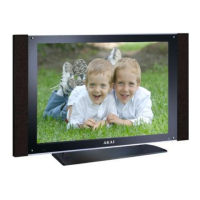Product Specification
/
LC420W02
Liquid Crystal Display
Ver. 1.1 August.12, 2004
3-2. Interface Connections
This LCD module employs two interface connections, a 30-pin connector is used for the module electronics
and two 12-pin connectors are used for the integral backlight system.
3-2-1. LCD Module
- LCD Connector(CN1) : FI-X30SSL-HF (Manufactured by JAE) or Equivalent
- Mating Connector : FI-X30C2L (Manufactured by JAE) or Equivalent
Table 4. MODULE CONNECTOR(CN1) PIN CONFIGURATION
LVDS Receiver Signal(+)RD+
25
LVDS Receiver Signal(-)RD-
24
GroundGND
23
LVDS Receiver Clock Signal(+)RCLK+
22
LVDS Receiver Clock Signal(-)RCLK-
21
LVDS Receiver Signal(-)RB-
15
GroundGND
14
LVDS Receiver Signal(+)RA+
13
LVDS Receiver Signal(-)RA-
12
GroundGND
11
External V
BR input from System to LCD moduleVBR_EXT
28
GroundGND
29
2
GroundGND
30
Power Supply +12.0V
V
LCD
2
Power Supply +12.0V
VLCD
3
Power Supply +12.0V
V
LCD
4
GroundGND
5
GroundGND
6
GroundGND
7
GroundGND
8
1
Select LVDS Data formatSelect
9
AI Enable ( ‘H’ = Enable , ‘L’ = Disable )
Enable
10
LVDS Receiver Signal(+)RB+
16
GroundGND
17
LVDS Receiver Signal(-)RC-
18
LVDS Receiver Signal(+)RC+
19
Ground
GND
20
GroundGND
26
V
BR output from LCD moduleVBR_OUT
27
NoteDescriptionSymbolPin No.
VLCD
Power Supply +12.0V
1
Note: 1. If Pin 9 is Ground, Interface format is “LG”, and if Pin9 is Vcc(3.3V), Interface format is “DISM”
See page 9 and 10.
2. Pin 30 should be ground, this pin is necessary for LCD test.
3. All GND(ground) pins should be connected together, which should be also connected to the LCD
module’s metal frame.
4. All V
LCD (power input) pins should be connected together.
5. Input Level of LVDS signal is based on the IEA 664 Standard.

